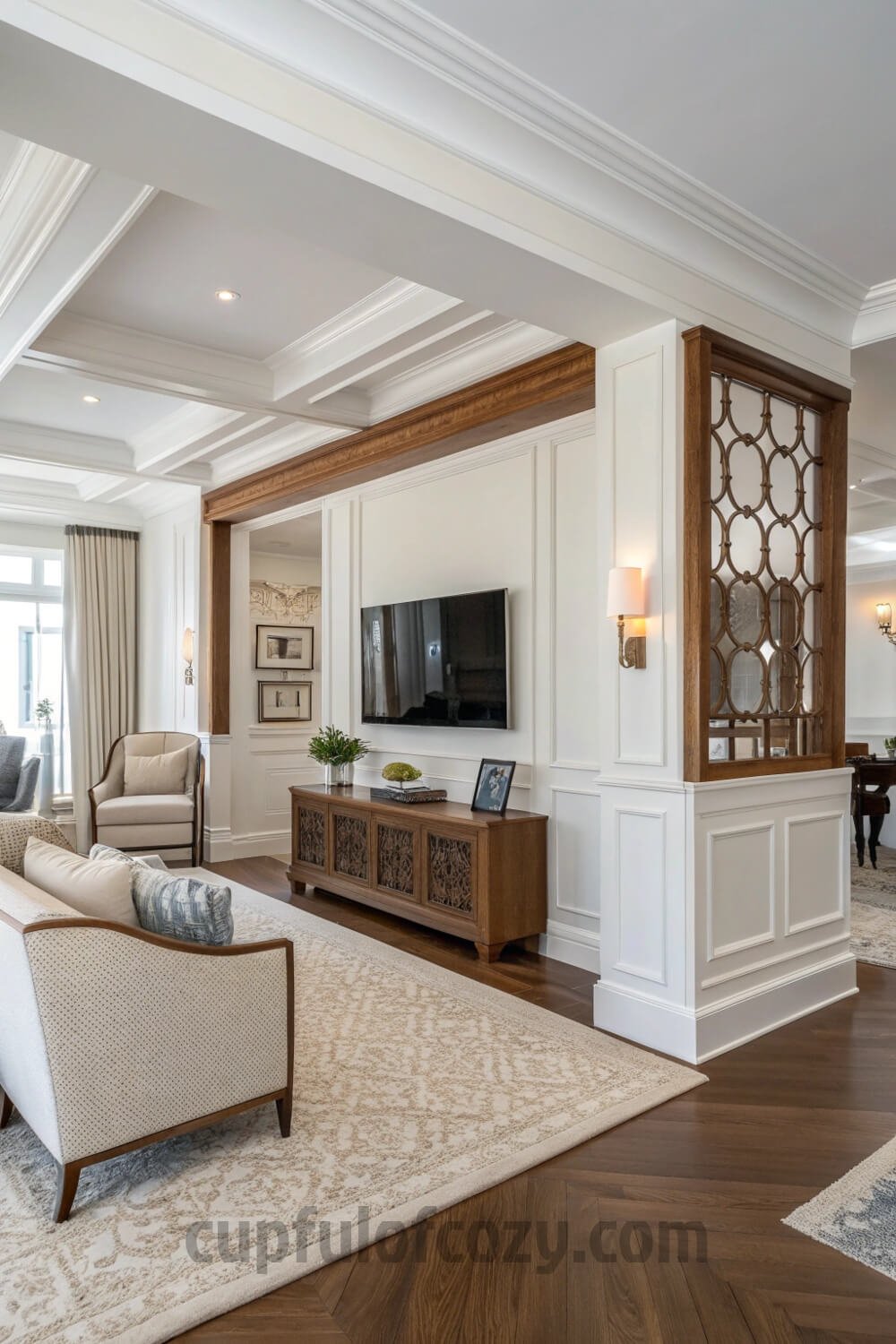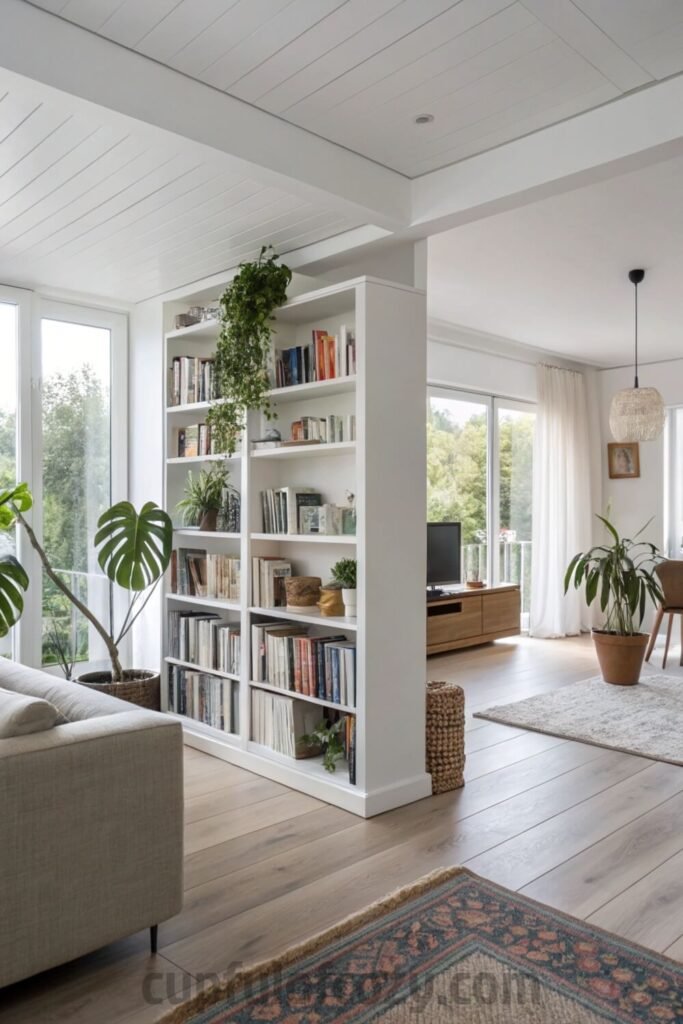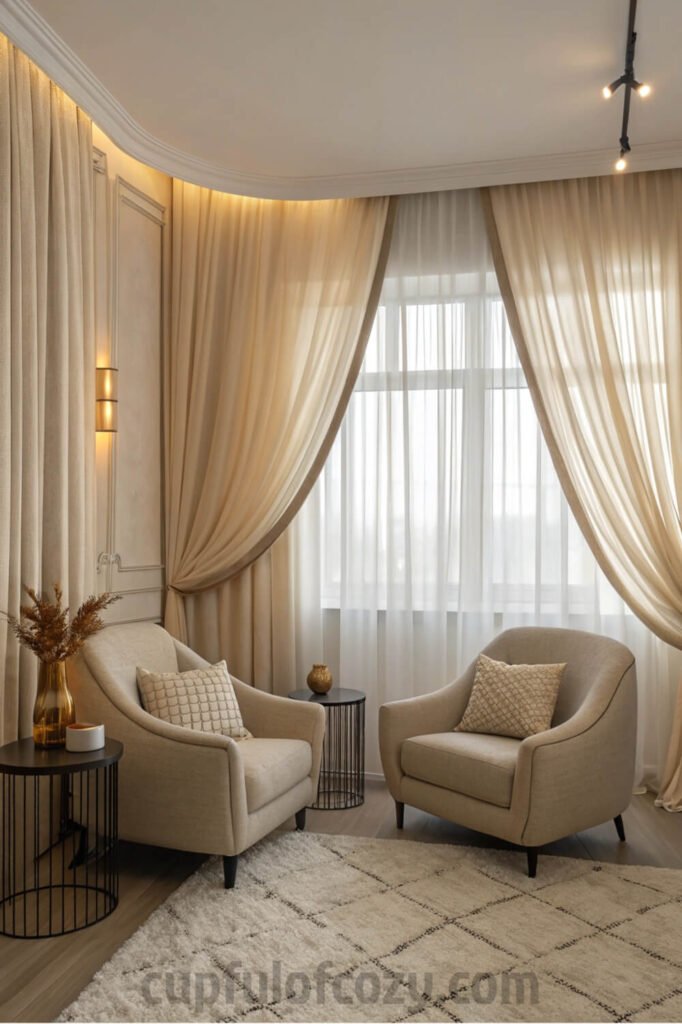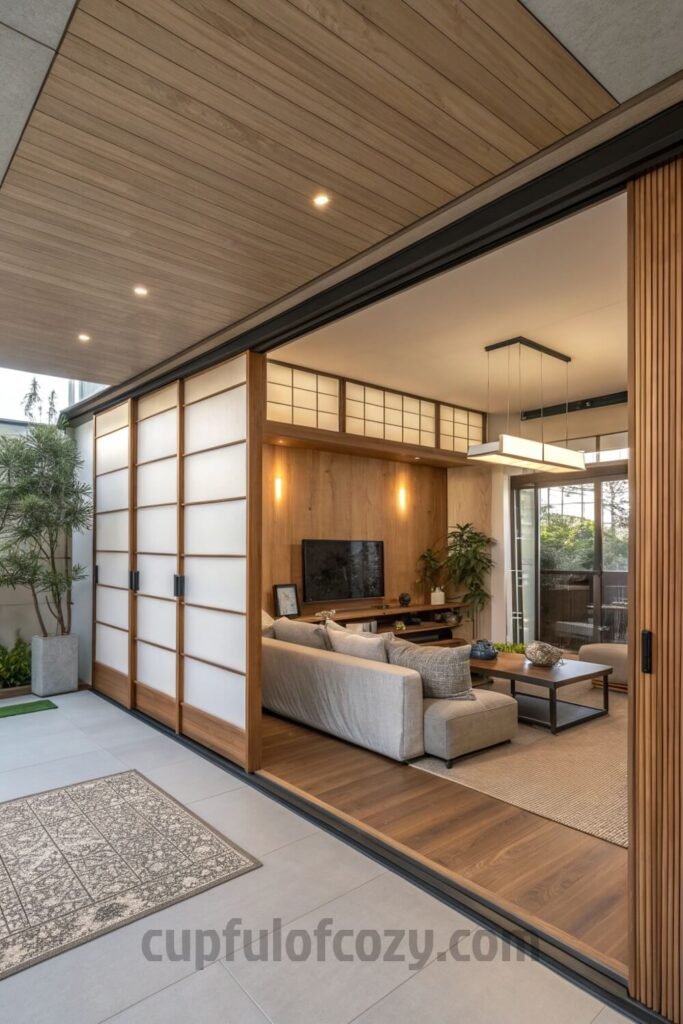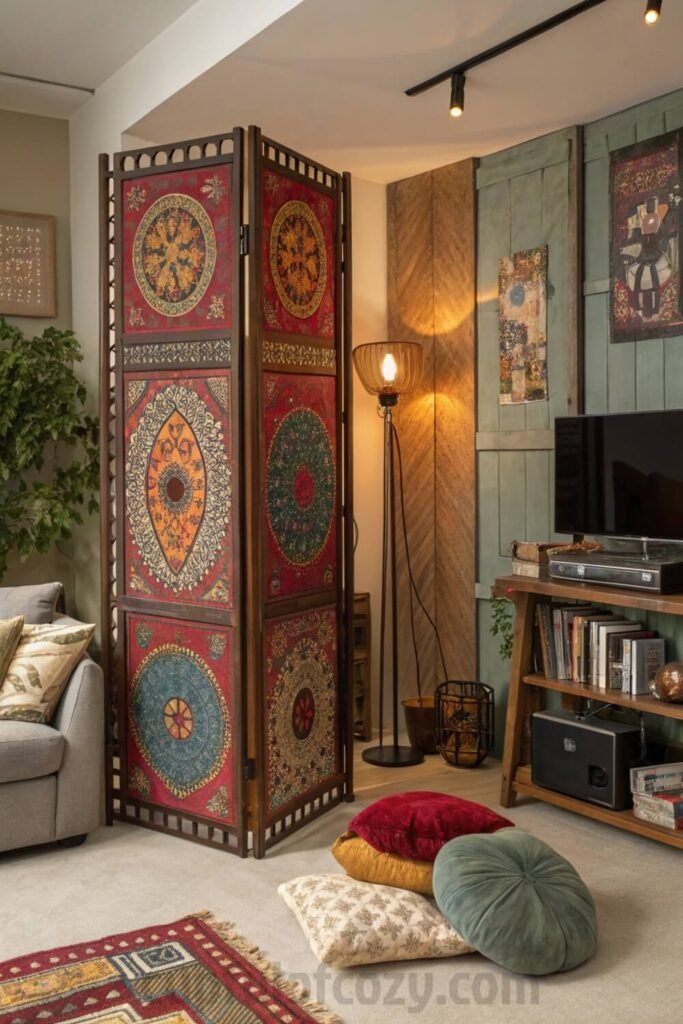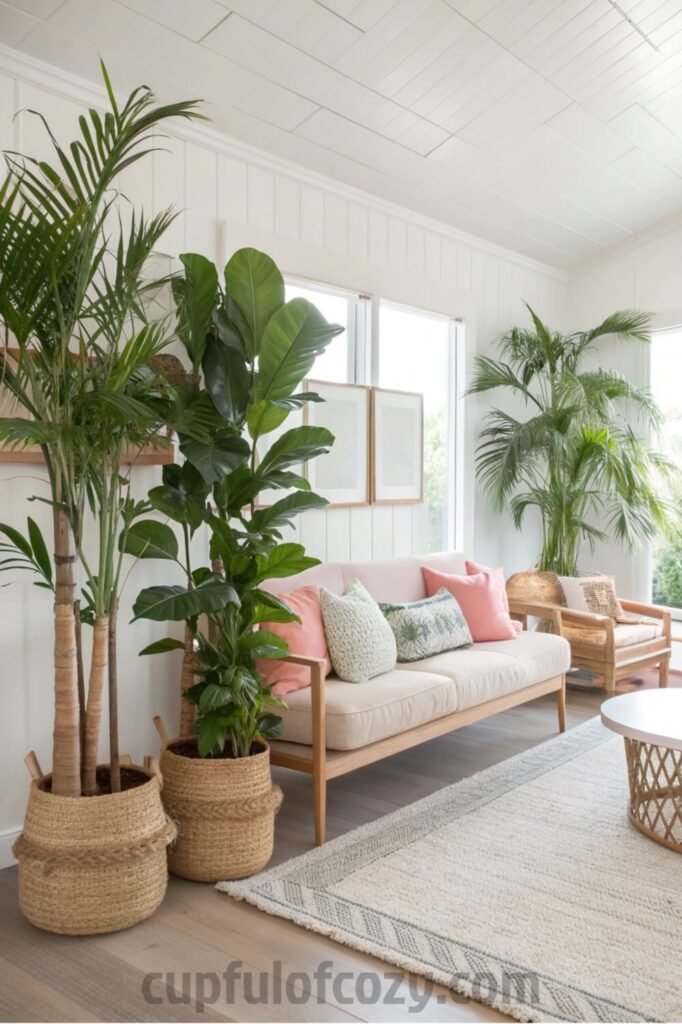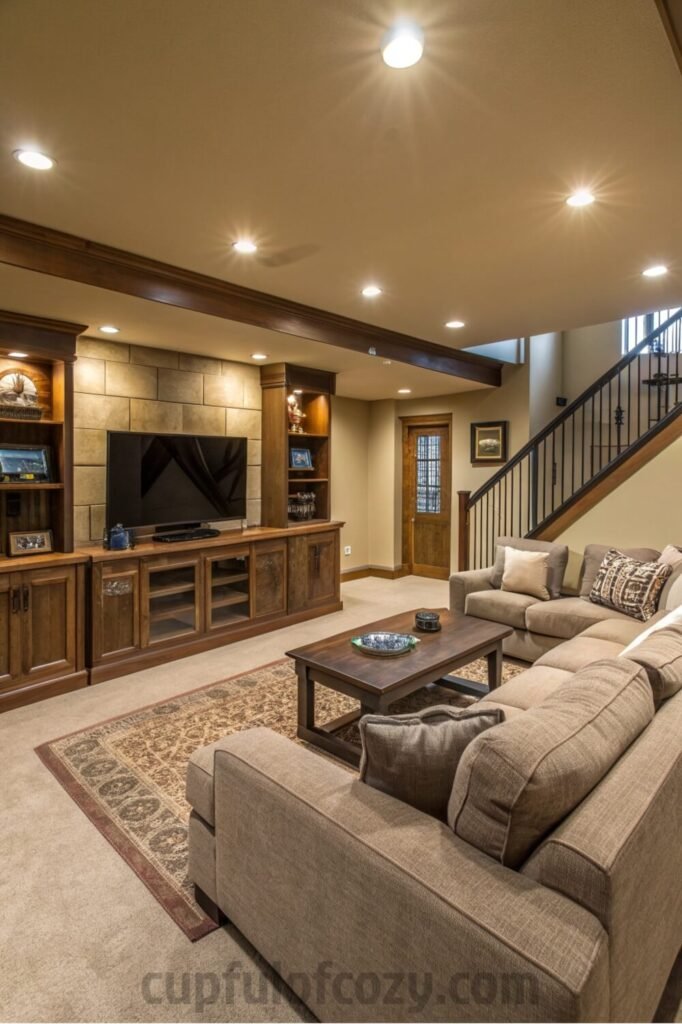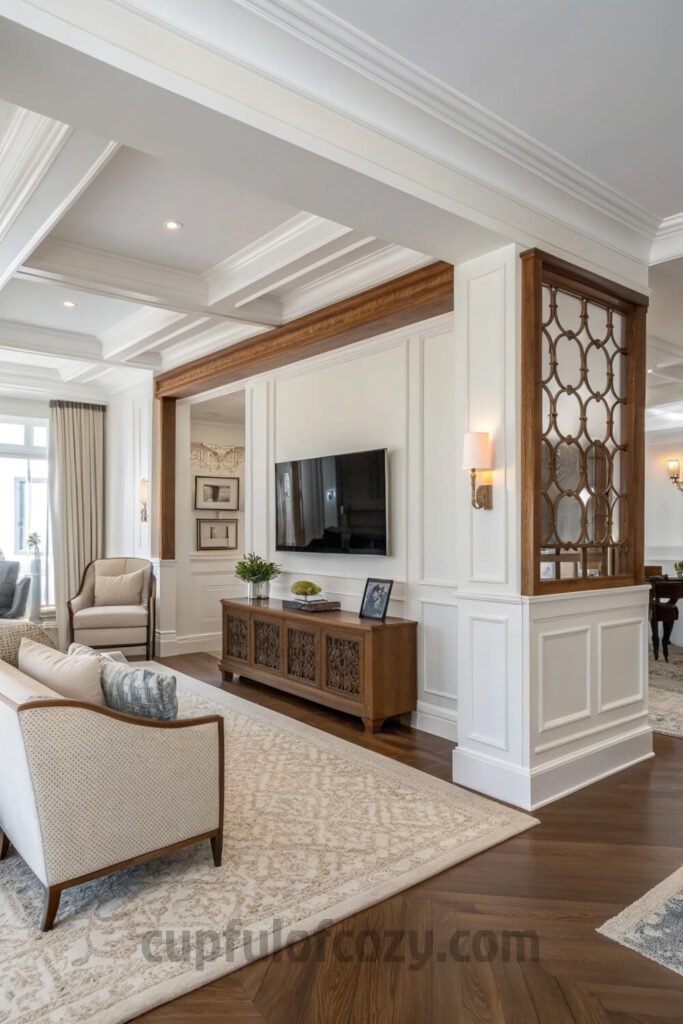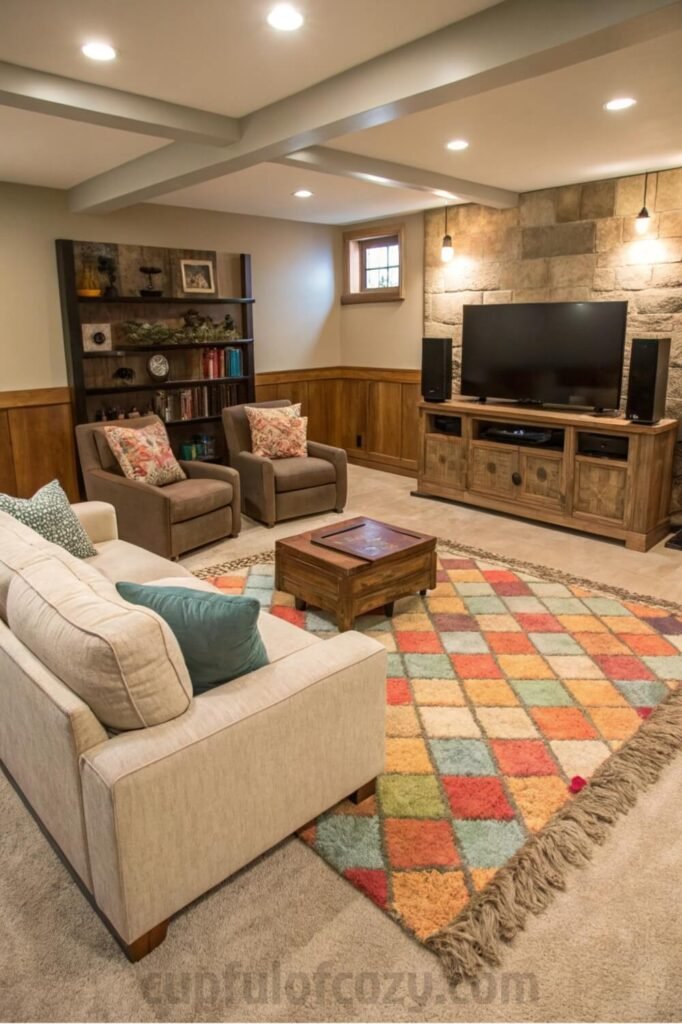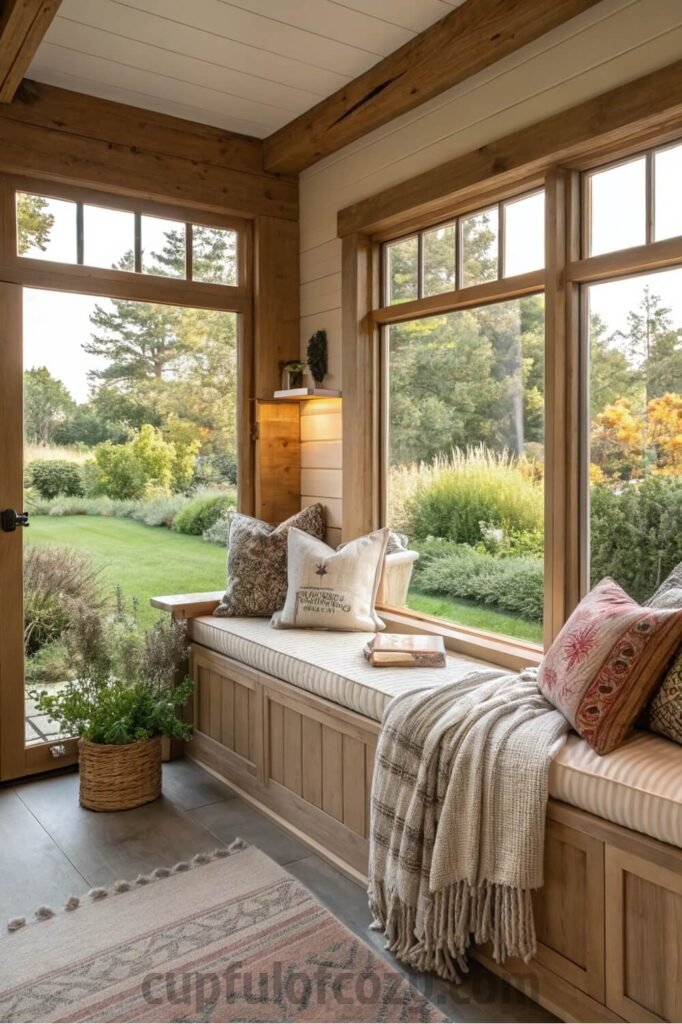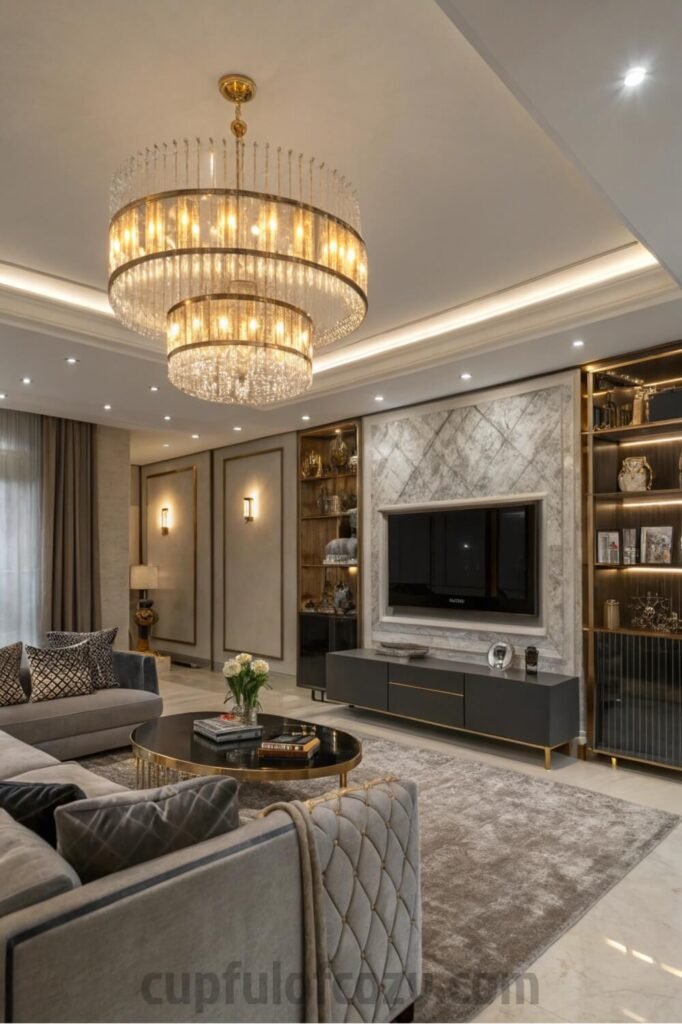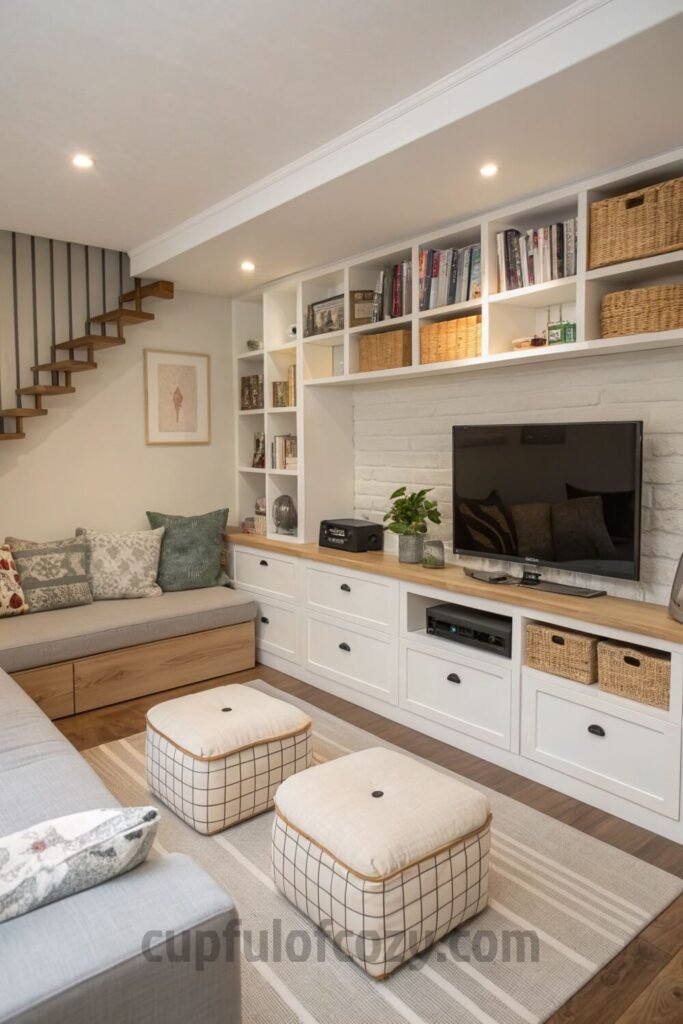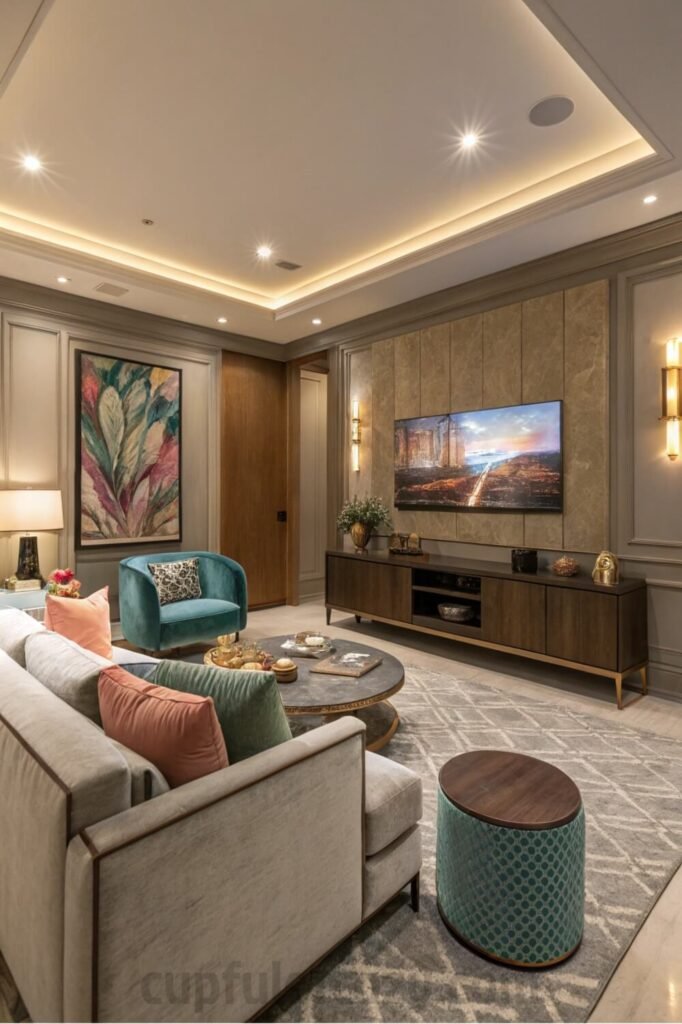That moment when you’re trying to have a deep heart-to-heart with your sister while your kids are blasting cartoons at full volume? Or when you want to curl up with a book but the TV’s calling everyone’s name? I’ve been there, and it used to drive me crazy until I figured out how to make my living room work double duty without feeling cramped or weird.
Here’s the thing: you don’t need to knock down walls or hire some fancy designer to create two functional spaces in one room. I’m about to spill all the tricks I’ve learned (some from Pinterest deep dives at 2 AM, others from pure desperation and creativity), and these ideas will change how you think about your space.
1. The Bookshelf Partition That Actually Works
This one’s my favorite because it’s like getting a room divider and storage solution rolled into one gorgeous package. I saw this setup at my cousin’s place in Denver last summer, and I literally took photos because I was so obsessed. She had this beautiful open bookshelf running perpendicular to the wall, creating this perfect little reading nook on one side and keeping the TV area separate on the other.
What I love most? Light still flows through both spaces, so nothing feels closed off or dark. You can go with a tall, dramatic piece that reaches almost to the ceiling, or keep it hip-high if you want more visual connection between the zones. I love mixing books with plants, family photos, and maybe a few pretty baskets for hiding remotes and random stuff. It’s functional art, basically.
2. Curtains That Actually Work (And Look Amazing)
Curtains as room dividers are criminally underrated. I used to think they’d look cheap or college-dorm-ish, but then I stayed at this boutique hotel in Santa Fe where they had these gorgeous linen panels hanging from ceiling tracks, and it was chef’s kiss perfect.
The beauty of curtains is that you get to choose your mood. Want the whole space to feel open and flowing? Pull them back. Need some privacy for your book club meeting while the family watches a movie? Close them up and create your own little sanctuary. I went with a warm terracotta color that complements my existing decor, and it adds this cozy, intimate vibe that makes everything feel more intentional.
3. Sliding Doors for the Modern Soul
This one’s for my friends who love that clean, contemporary look but still want flexibility. Sliding doors or panels can be total game-changers, especially if you go with something unexpected like frosted glass or even reclaimed wood. My neighbor just installed these beautiful shoji-style screens, and every time I walk into her place, I feel like I’m in some zen spa.
The best part? When they’re open, you barely notice them, but slide them closed and boom: you’ve got two completely separate rooms. It’s like living room wizardry, and it makes the whole space feel more expensive and thoughtfully designed.
4. Folding Screens for the Commitment-Phobic
Not all of us are ready for permanent changes, and that’s totally okay! Folding screens are like the dating-without-labels of room dividers: flexible, non-committal, and surprisingly stylish. I found this gorgeous hand-painted one at a vintage market in Albuquerque, and it’s become such a conversation starter.
- Before you hit “buy” on your next decor order, there’s a free 10-second step you should never skip: checking Rakuten (Ebates). I simply find the store name, click the deal, and shop like normal, and Rakuten sends me real cashback! Prices keep climbing everywhere, but this is one way to get a little back on the things you were going to purchase anyway. New members even get a $30 bonus when they spend $30 — which means your first order could pay you back instantly. Don’t miss out again. Click here to sign up and save money!
*Disclosure: This post includes affiliate links. I may earn a small commission if you join Rakuten through my link — but it doesn’t cost you anything extra. In fact, you’ll actually save more!
What gets me excited is that you can move it around depending on your needs. Hosting a party? Fold it up and store it away. Need some separation for homework time versus family movie night? Set it up in minutes. Plus, they come in so many styles, from minimalist wood frames to ornate vintage finds, that you can really let your personality shine through.
5. Plant Partition Paradise
This idea came to me during one of my plant-buying binges (don’t judge, we all have our weaknesses). I realized that my collection of tall plants could actually serve a purpose beyond just making me feel like I have my life together. Strategic plant placement can create the most gorgeous, natural room divider that brings life and freshness to both spaces.
My grandmother always said plants make a house feel alive, and she was right. A few tall fiddle leaf figs or some dramatic snake plants lined up can create a soft boundary that doesn’t feel harsh or blocking. Plus, there’s something so calming about having greenery define your conversation corner. It makes intimate chats feel more special, like you’re sitting in a secret garden inside your own home.
6. Strategic Furniture Arrangement (The Free Option!)
Sometimes the best solutions are right under our noses, literally. I had this lightbulb moment when I was rearranging after my last move: what if I just turned my sectional around so it faces away from the TV? Suddenly, I had a natural conversation area that felt completely separate from the entertainment zone, and it didn’t cost me a single penny.
The trick is thinking about sight lines and flow. Position a loveseat with its back to the TV area, add a small side table and maybe a floor lamp, and you’ve created an instant cozy corner. Meanwhile, your main entertainment seating can face the TV without any distractions. It’s so simple but incredibly effective.
7. The Half-Wall Solution
This one requires a bit more commitment (and maybe a handy partner or friend), but hear me out. A low pony wall can give you that defined separation while keeping everything feeling open and connected. I saw this done beautifully at my friend’s place: she had her dad build a knee-high wall with a flat top that doubles as extra surface space for drinks and books.
The genius is in the height, it creates a clear boundary for each zone without blocking light or making either space feel cramped. You can even add some built-in shelving or make the top wide enough to display plants or art. It’s like getting extra storage and a room divider in one smart package.
8. Rug Definition That Works
This trick is so simple it almost feels like cheating, but it works like wonder. Different rugs for different zones instantly tell your brain (and your guests) that these are separate spaces with different purposes. I learned this from watching way too many home makeover shows during a particularly stressful period last year.
For the conversation area, I went with something plush and inviting: a soft, neutral rug that makes you want to kick off your shoes and sink into the couch. For the entertainment zone, I chose something more durable and playful that can handle movie night snacks and game day excitement. The visual contrast creates clear boundaries without any physical barriers.
9. Window Seat Dreams
If you’re lucky enough to have a window in your living room, this idea might just make you fall in love with your space all over again. Creating a dedicated window seat for your conversation corner is like giving yourself a built-in cozy retreat. I visited my aunt in Portland last fall, and she had transformed her bay window into this incredible reading and chatting nook with custom cushions and tons of pillows.
Even if you don’t have a bay window, you can create something similar with a bench or even just a collection of floor cushions near any window. Add some soft throws, maybe a small side table for tea or coffee, and you’ve got the perfect spot for those deeper conversations or quiet moments with a book.
10. Lighting That Sets the Mood
This one’s all about creating atmosphere and defining purpose through light. Different lighting for each zone is like giving each space its own personality. For my conversation corner, I went with warm, soft lighting: a combination of table lamps and maybe a statement floor lamp that creates this intimate, golden glow perfect for chatting.
The entertainment area gets more functional lighting, maybe some recessed lights or spots that provide good visibility for activities without creating glare on the TV screen. The contrast in lighting styles naturally guides people to use each space for its intended purpose, and it makes your whole living room feel more sophisticated and intentional.
11. Smart Storage That Works Double Duty
Storage solutions that also function as dividers are basically the holy grail of small space living. I’m talking about ottomans that store blankets and board games, storage benches that create natural boundaries, or even a console table behind your conversation seating that holds books, plants, and all those little things that need a home.
These pieces earn their keep by solving multiple problems at once: they organize your stuff, help define your zones, and often provide extra seating when you need it. It’s efficient design that doesn’t sacrifice style, which is exactly what most of us need in our real-life homes.
12. Color and Decor Storytelling
This last one might be my secret weapon for creating distinct zones that still feel cohesive. Using different but complementary color schemes and decorating styles in each area is like visual storytelling: each zone gets to express its purpose through design choices.
For the conversation corner, I leaned into calming neutrals, soft textures, and personal touches that make intimate conversations feel natural. Think cream and sage tones, cozy throws, family photos, and maybe a few meaningful books displayed just so. The entertainment area gets to be more dynamic: bolder colors, fun patterns, and accessories that can handle the energy of family movie nights or game sessions.
What makes this work is when both areas feel connected through shared elements, maybe the same wood tones or a repeated accent color, so your living room feels intentionally designed rather than accidentally divided.
Final Thoughts
Here’s what I’ve learned after trying most of these ideas in my own space: the best room division solution is the one that fits your lifestyle, budget, and aesthetic. Some of these ideas cost almost nothing (hello, furniture rearrangement!), while others are more of an investment. What matters is picking something that makes your daily life easier and your space more enjoyable to spend time in.
Your living room should work for you, not against you. Whether you’re hosting intimate coffee dates or family movie marathons, these division ideas can help you create a space that truly serves your life. And there’s something so satisfying about walking into your living room and feeling like every corner has a purpose and a personality.
- Before buying anything online, check Rakuten (formerly Ebates) — either with the browser extension or directly on Rakuten.com. Just type in your store, click the current deal, and shop as usual. Every purchase earns you cashback that can be mailed to you or sent via PayPal. In today’s economy, even a few dollars back can turn into a Starbucks latte, McDonald’s fries for the kids, or a little treat you don’t have to budget for. If you’ve never used Rakuten before, you’re missing out on free money — and right now, you’ll even get a $30 bonus when you spend your first $30. Click here to sign up and stop letting your online orders steal from you. Click here to sign up and save money!
*Disclosure: This post includes affiliate links. I may earn a small commission if you join Rakuten through my link — but it doesn’t cost you anything extra. In fact, you’ll actually save more!

